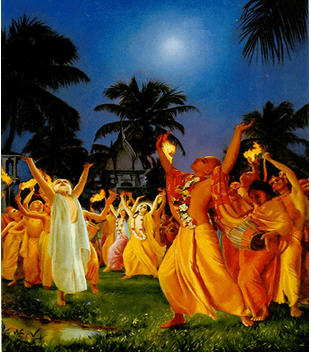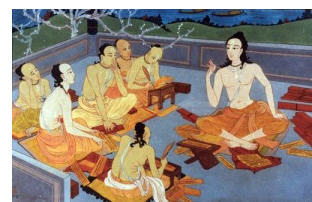tato gatva bharadvaja- sthanamsankirtayan harim
tato mayapuravasam pravivesa svayam harih
“Lord Gaurahari then went to Bharadvaja-sthana and performed hari sankirtana.Then He personally entered the abode of Mayapur.”
(Navadvipa dhama-mahatmya, Pramana-khanda4.56) This place is located at the end of the village called Bharui-danga. Amonument has been constructed there by the Bhaktivedanta Swami Charity Trust (BVSCT). Bharadvaja Muni was sitting on a raised tila (hillock) performing his gaura-bhajana, therefore this place is called Bharadvaja-tila. Srila Bhaktivinoda Thakura wrote in his Navadvipa-bhava-taranga: “There(in Ganganagara), one can see the lovely hill known as Bharadvaja-tila, where the great sage Bharadvaja worshiped Lord Gaura. The sage ultimately attained ecstatic love for Lord Caitanya and then wrote scriptural verses that bestowed the gift of devotional service unto many materialistic people.”

Isana Thakura explained to Sri Srinivasa that this village is known as Bharui-danga. Previously Bharadvaja tila was situated here. After travelling to many tirthas including the samudra(the great ocean), Bharadvaja Muni came to a place called Cakra-daha. It isnow known as Chak daha and is situated on the bank of the Ganga. From there he visited Navadvipa-dhama. Upon seeing the beauty of Navadvipa the muni became very ecstatic. He settled here on top of this tila (hillock) in a very simple and humble manner, worshiping Lord Gauranga. Being pleased by the pure love of Bharadvaja Muni, Lord Gaurahari revealed to him His most wonderful form. The sage offered his prostrated obeisance as well as many prayers and the Lord told him to ask for any boon he desired. The muni replied, “O my Lord! My only prayer is that You please bless me so that I will see Your manifested pastimes here in Navadvipa-dhama.”The Lord said, “Let it be so. Your desire will be fulfilled. You will have My darsana during My manifested pastimes.” Saying this, the Lord disappeared from the vision of the sage, who fell to the ground offering his humble prostration to Navadvipa dhama before continuing his pilgrimage. Bharadvaja Muni was sitting on araised tila (hillock) while engaged in his gaura-bhajana, therefore this placeis called Bharadvaja-tila.(Bhakti – ratnakara)


